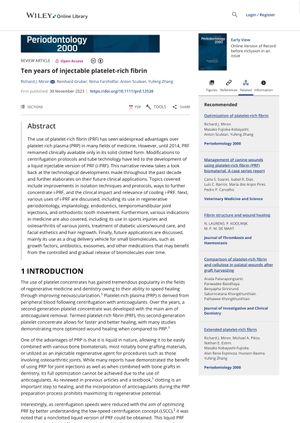Ten Years of Injectable Platelet-Rich Fibrin
November 2023
in “
Periodontology 2000
”

TLDR Injectable platelet-rich fibrin has improved healing and regeneration in various medical fields and can be more effective than previous treatments.
The document reviews the development and use of injectable platelet-rich fibrin (i-PRF) and concentrated platelet-rich fibrin (C-PRF) in regenerative medicine and dentistry over the past decade. i-PRF, which can be used for about 15-20 minutes before clotting, releases growth factors more gradually than its predecessor, platelet-rich plasma (PRP), leading to better healing. The use of horizontal centrifugation has led to a fourfold increase in cell concentration in i-PRF. C-PRF has shown a significant increase in platelet and leukocyte yields compared to i-PRF. i-PRF has regenerative properties, can reduce inflammation, and increase the expression of various growth factors in cells. It has been used in various fields including wound healing, root resorption, periodontal regeneration, bone regeneration, endodontics, orthodontics, and temporomandibular joint disorders. In a study involving 44 patients with venous leg ulcers, i-PRF promoted healing and wound closure. In facial aesthetics, i-PRF stimulated greater dermal skin fibroblast cell migration, proliferation, and collagen synthesis compared to PRP. A 2021 study showed that i-PRF facilitated hair follicle regeneration. The use of hydrophobic tubes and cooling devices can extend the working time of i-PRF up to 4 hours. More research is needed, but the ability to delay clotting and utilize i-PRF as a scaffold opens many avenues for future research.
